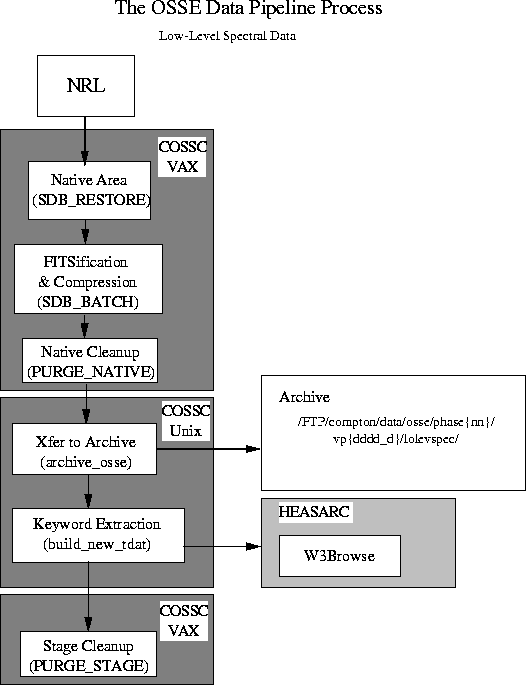 |
The procedure for processing low-level OSSE data is composed of four main segments which run sequentially. All work is done in the OSSEPIPE account on VMS and the ARCHIVER account on Unix.
It may be worthwhile in the future to incorporate the PDF file processing into the SDB pipeline.
For control purposes, a processing form is maintained for each data delivery and installation into the archive. For this portion of the pipeline, this form is called OSSEPIPE-01. You should utilize the most recent release of this form.
 |
| OA | SDB (spectral) data |
| OB | PDF (timing & pulsar) data |
| OD | TELEMETRY data (which is not archived) |
The last four characters of the label are digits denoting the first day of the viewing period. Specifically, the first digit in the code is the last digit of the year number, and the last three digits of the code are the day number within that year. For instance, a tape labeled ``OB2136'' contains PDF data whose viewing period began on the 136th day of 1992 (year number ends in 2).
Log listings of the contents of the delivered data tapes are stored in $DISK10:[INVENTORY.OSSE].
For ISO-9000 and control purposes, each viewing period processed will be recorded on a pipeline control form. For the low-level spectral pipeline, the form is designated OSSEFORM-01.
When the data tapes arrive and are recorded in inventory, the header of the form should be filled out. The header records the basic inventory information - CGRO viewing period number, the data delivery number, tape identifier label, and the tape delivery date.
Get the viewing period date and length from the CGRO viewing plan.
The length of the proprietary period is determined by the CGRO phase number per the table below:
| phase | length |
| 12 months | |
| 7 | 6 months |
| 8 | 3 months |
| none |
From this, determine the date of the end of the proprietary period and record it on the form. If this date has passed, you may continue with the steps to load the data into the archive.
The program to restore data files from tape to disk assumes that the desired tape is loaded in tape drive connected to GROVX0 and referenced by the symbol OSSE_TAPE, and must be run from the OSSEPIPE account on GROVX0. The restoration software includes performing the allocation and mounting of the tape drive.
To execute, type:
@SDB_RESTORE [deliv_num] [tape_label]or
@PDF_RESTORE [deliv_num] [tape_label]where [deliv_num] is the tape delivery number and [tape_label] is the identifier marked on the tape.
For example, the command
@SDB_RESTORE 111 OA3361will restore all files from tape OA3361 in delivery 111.
The next step is to convert the data files from native format to FITS format. This is accomplished by submitting the format conversion program to a batch queue from the OSSEPIPE account.
To execute, type:
@SDB_BATCH [deliv_num] [view_period] [time]or
@PDF_BATCH [deliv_num] [view_period] [time]
where [view_period] is the corresponding viewing period number (note there should always be one digit to the right of the decimal point) and [time] is an (optional) start time for the batch job [hh:mm]
For example, the command
@SDB_BATCH 111 313.0 20:00will submit the FITS conversion software as a batch job that will begin at 20:00 to process the SDB files from delivery 111, containing data obtained during viewing period 313.0.
On completion of FITSification, the pipeline activity moves over to the Unix side of the system in the ARCHIVER account. Due to the file naming convention for the resulting TDAT files, this step can be run only once per day. Also note that case is important when typing in these commands.
Once in Unix
>cd osse >idl
whichs sets up the account to run IDL v5.0 and starts IDL. Once in IDL, we can transfer the files to the archive:
.run tdat_library .run archive_osse
The archive_osse process builds the output directory structure and transfers the data files to the archive. It will generally run for a while (an hour or so). The final step is
.run build_new_tdatwhich examines the FITS headers and extracts the information to generate the data tags for the entire OSSE archive. This data is tabulated in a pipe-delimited file: osse_nnnnnnn_build.tdat which appears in the osse_tdat directory on completion of this program (nnnnnnn is the Julian Day number). A copy of this file is also sent (via FTP) to hrcdba@dbsrv:/dba_dbase/work/osse/hdb/. On completion, an e-mail notification is sent to dba_browse@lheamail.gsfc.nasa.gov. When this process completes, type
exitto leave IDL.
As a precaution, the pipelines perform only a limited amount of `clean-up' behind them to facilitate restarting in the event a run fails. The actual clean-up is best performed manually after there has been plenty of time to ensure the previous runs did complete successfully.
There are two subdirectory areas that should be empty before initiating a new pipeline run. WARNING - MAKE SURE THAT ALL OSSE PIPELINE PROCESSES ARE COMPLETE BEFORE RUNNING THESE PROGRAMS.
@PURGE_NATIVE [dn]where [dn] is either the data delivery number, to delete a specific delivery, or `*' to delete all low-level data deliveries from the native area. The program prompts you with a warning of what it is about to do. Nonetheless, use it with caution.
@PURGE_STAGE [type] [vp]where [type] is the data types: lolevspec, hilevspec, pulsar, or `*' to purge all types; and [vp] is the viewing period you desire to delete, or `*' to delete all.